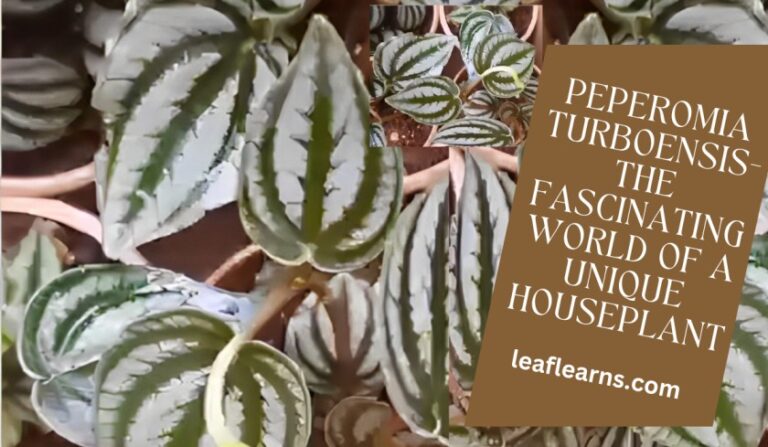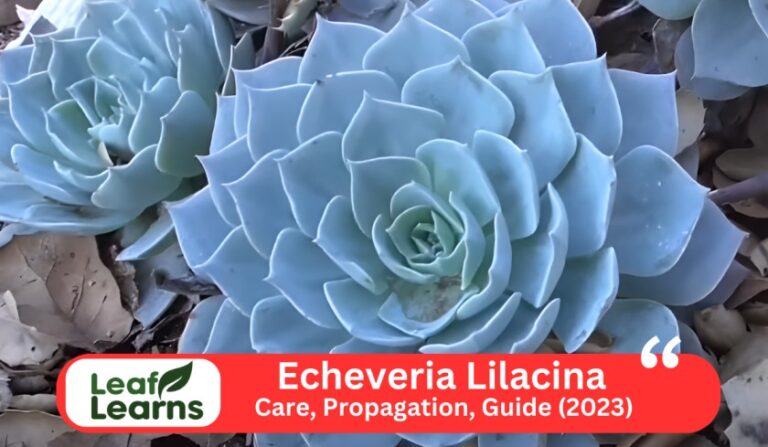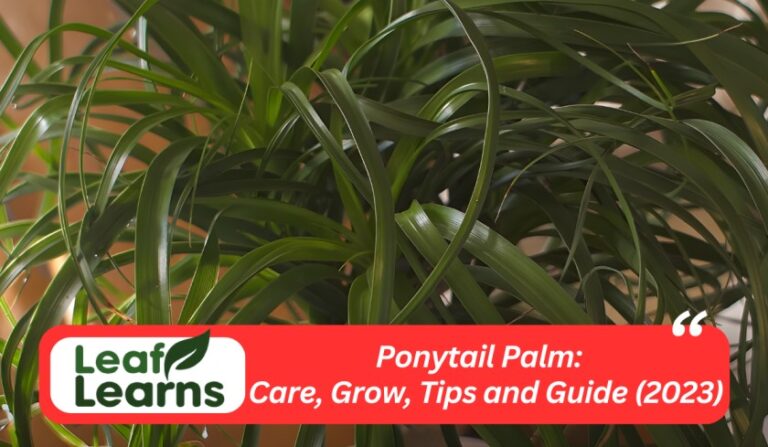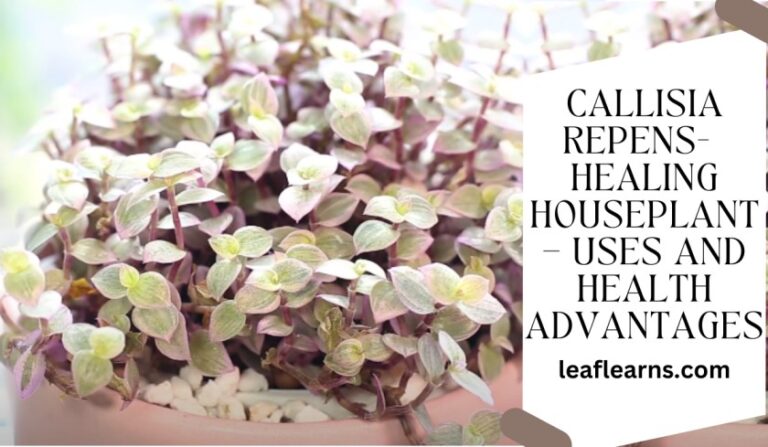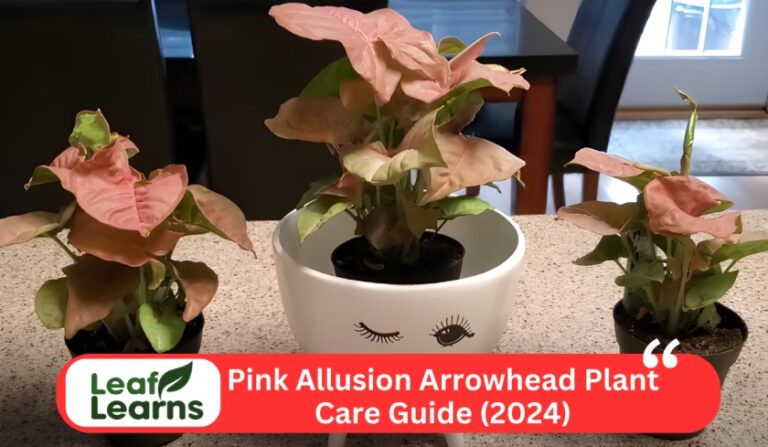Philodendron Lemon Lime Care, Propagation and Guide (2023)
The Philodendron Lemon Lime scientifically called as Philodendron hederaceum ‘Lemon Lime,’ is very popular houseplant. It is belonging to the Araceae family. It origianate and distribute from Central to South America. This stunning popular plant can reach a height of up to 3 feet (0.9 meters) in size. This plant having dark green leaves are its main feature Making the plant beautiful by adding the red colour of the flower.
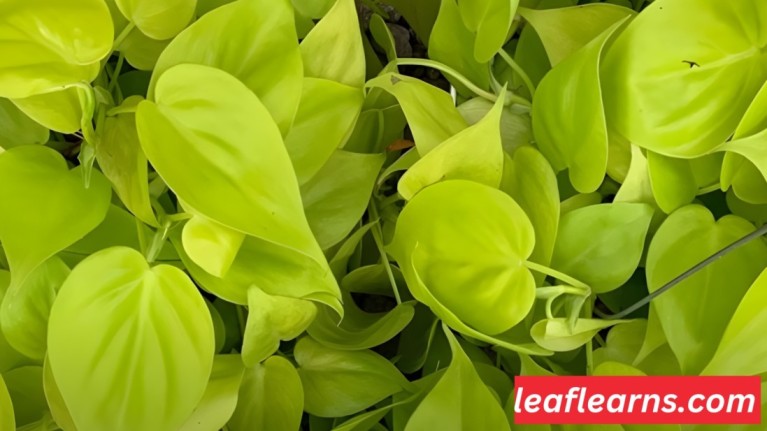
It look like beautifull heart. This plant required maintainance of its health and appearance, it Needs to bring it on the bright indirect sunlight and also placed it in the well-draining potting mix soil with a slightly acidic pH between 6.4 to 7.3.
The plant Philodendron Lemon Lime placed in the humidity levels at 50% or higher and its important for its health. Water gives to this plant when the top half if the soil become dry. This beautiful plant pruning can help control its size and eliminate dead or yellowing leaves to make the plant beautiful.
Propagation can be easily done by stem cuttings or air layering. It’s essential to see out for potential pests like spider mites, mealybugs, or thrips, that can cause to decease its growth. Overall, the Lemon Lime Philodendron is a striking and manageable addition to any indoor garden.
| Common name | Lemon Lime Philodendron |
| Scientific Name | Philodendron hederaceum ‘Lemon Lime’ |
| Family | Araceae |
| Distribution | Central to South America |
| Plant type | Houseplant |
| Size | Up to 3 feet (0.9 meters) in height |
| Leaf Colour | dark-green |
| Propagation | Stem cuttings, air layering |
| Temperature | 65-80°F (18-27°C) |
| Humidity | 50% or higher |
| Pruning | Prune to control size and remove dead or yellowing leaves |
| Light requirement | Bright indirect sunlight |
| Soil requirement | Well-draining potting mix |
| Watering Need | Water if the top half of the soil is dry |
| Soil pH | 6.4 to 7.3 |
| Flower colour | Red |
| Pests | Spider mites, mealybugs, or thrips |
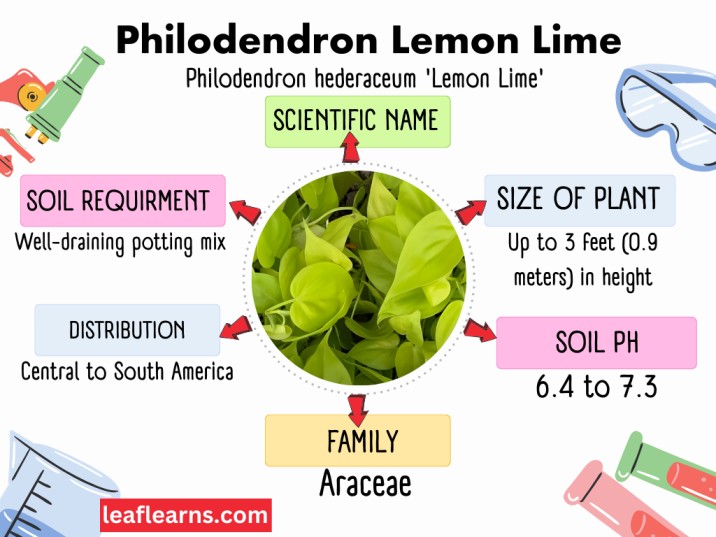
Contents
- 1 Top Care Tips
- 2 Care for Philodendron Lemon Lime
- 3 Pruning
- 4 Growth Rate and Size
- 5 Propagating Philodendron Lemon Lime
- 6 Repotting
- 7 Flowering and Foliage
- 8 Overwintering
- 9 Philodendron Lemon Lime vs Neon pothos
- 10 Common Pests
- 11 Plant Diseases
- 12 How to Get to Bloom
- 13 Problems and Solutions
- 14 Toxicity
- 15 Fun Facts About Philodendron Lemon Lime
- 16 Philodendron lemon lime Appearance
- 17 Suggested Uses
- 18 Essential Care Tips for Thriving Lemon Lime Philodendrons
- 19 Distinguishing Between Neon Pothos and Lemon Lime Philodendrons
- 20 Conclusion
- 21 FAQs
Top Care Tips
Light: A location where your Lemon Lime Philodendron may get bright, indirect sunshine should be chosen. Avoid the sun’s rays; they might damage the foliage.
- Watering: Between waterings, allow the top inch of the soil to dry out. If the soil feels dry when you stick your finger into it, it’s time to water. It can get root rot if you leave it submerged in water.
- Soil: To guarantee proper airflow to the roots and prevent soggy soil, use well-draining potting soil.
- Humidity: These plants enjoy moisture. To keep the plant’s leaves wet, mist them every so often or have a tray of water close by.
- Fertilizing: During the growing season (spring and summer), give your Lemon Lime Philodendron a balanced, water-soluble fertilizer every four to six weeks. During the winter and autumn dormant season, reduce feeding.
Care for Philodendron Lemon Lime
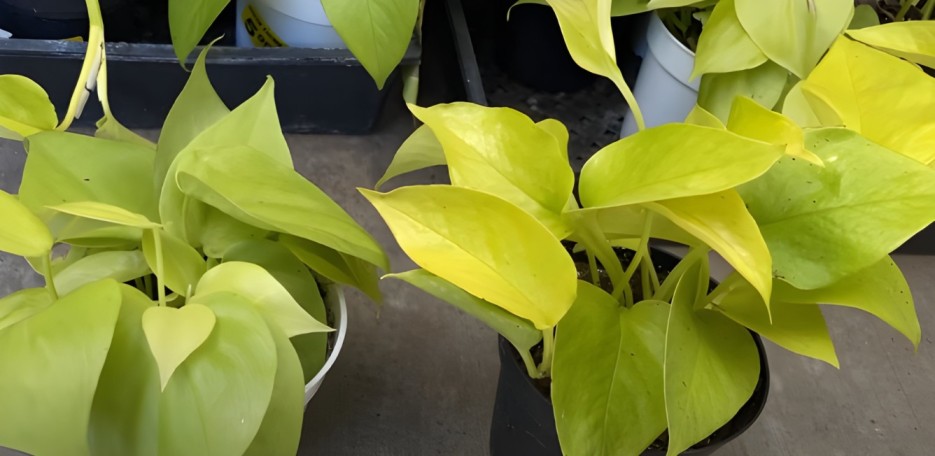
Light Requirement
Pay close attention to the amount of light your Lemon Lime Philodendron needs to thrive. Bright, filtered sunshine is perfect for these plants. Put your plant in a spot where it receives the type of soft light you may appreciate reading a book in front of a sunny window, but not the direct, hot sun.
It should not be placed in areas with insufficient light because this would hinder development and dull the vivid colours of its leaves. The plant needs more light if you see it reaching out for it or if the beautiful lemon and lime colours on its leaves start to fade.
Just bear in mind that your Lemon Lime Philodendron will remain healthy and happy if you can locate that “Goldilocks” location with just the proper amount of moderate sunshine.
Water Requirement
Simple yet essential for your Lemon Lime Philodendron health is watering. Think of the soil’s top inch like a traffic light. Water should not be applied prior to when the soil becomes dry.
Don’t rush to water this plant as soon as the soil feels a little dry on the surface; this plant loves to have a little dry time in between sips. This strategy avoids overwatering, which can cause root issues.
Your Lemon Lime Philodendron will remain happy and healthy if you simply let it to indicate its thirst.
Soil Requirement
Let’s discuss the easy soil requirements for your Lemon Lime Philodendron plant. A certain sort of soil that drains efficiently is required by your plant.
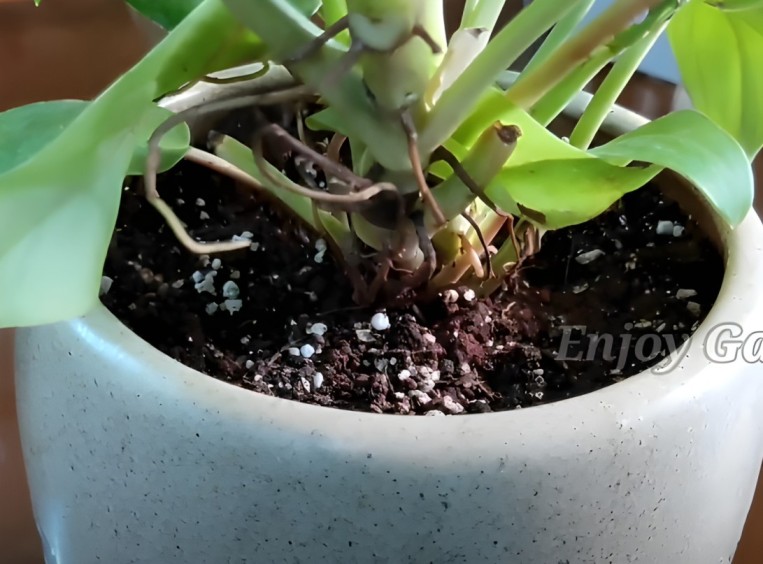
Consider this soil to be a sponge that can absorb water but doesn’t hold onto it for an extended period of time. It’s like providing the proper balance for your plant.
This helps keep your Lemon Lime Philodendron roots from becoming too moist, which is something they don’t enjoy. To keep your plant happy and healthy, pick well-draining soil when you pot it or repot it.
Temperature Requirement
The Lemon Lime Philodendron is a hardy and simple-to-care-for plant, but it’s crucial to understand its temperature needs. Because this plant needs a warm, steady climate, indoor growing is the best option.
Maintain temperatures in the Philodendron Lemon-Lime between 65°F and 80°F (18°C and 27°C). Keep it away from draughts and rapid temperature changes, such as those seen near air conditioning vents or windows in the winter.
Humidity Requirement
It’s crucial to pay attention to your Lemon Lime Philodendron’s humidity requirements if you want to keep it happy and healthy. A little moisture in the air is ideal for these plants.
You may take care of this demand by periodically misting the leaves with a spray bottle or by setting up a tray of water next to the plant.Therefore, don’t forget to add a little more hydration; your plant will repay you with brilliant, lemon-lime-colored leaves.
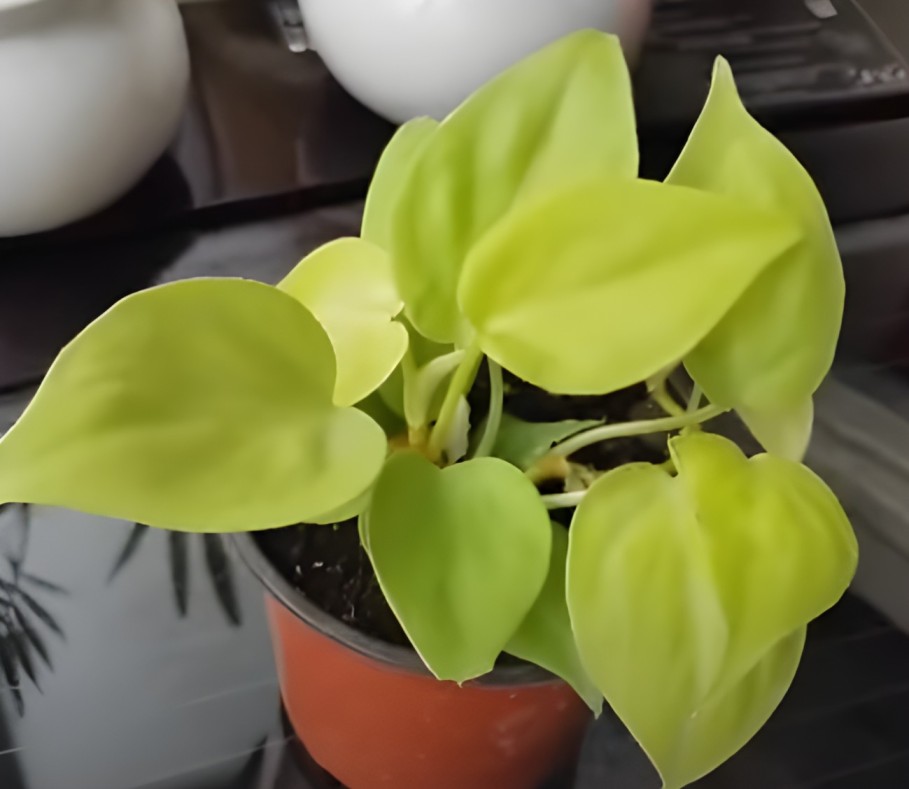
Fertilizer Requirement
It’s critical to comprehend your Lemon Lime Philodendron’s fertilizer needs if you want to maintain it healthy and joyful. Consider fertilizer to be plant food! Your plant will benefit from a meal every 4 to 6 weeks during the growing season, which is normally in the spring and summer.
Use a well-balanced, water-soluble fertilizer to give your Philodendron the nutrition it needs to thrive and develop its stunning lemon and lime-colored leaves. You can cut back on feedings in the autumn and winter when the plant is less active.
Potting Requirement
Understanding the potting needs for your Lemon Lime Philodendron is crucial to its care. Select a well-draining potting mix that enables extra water to run away from the roots if you want to maintain this colourful plant healthy and happy.
A plant’s health can be harmed by root rot, which is avoided by having well-draining soil. To further aid water drainage, make sure your pot includes drainage holes at the bottom.
When your Philodendron-Lemon Lime outgrows its present container, repot it to give it more area to expand. Your plant will grow and show off its lovely lemon and lime-colored leaves if you use the proper potting soil and container.
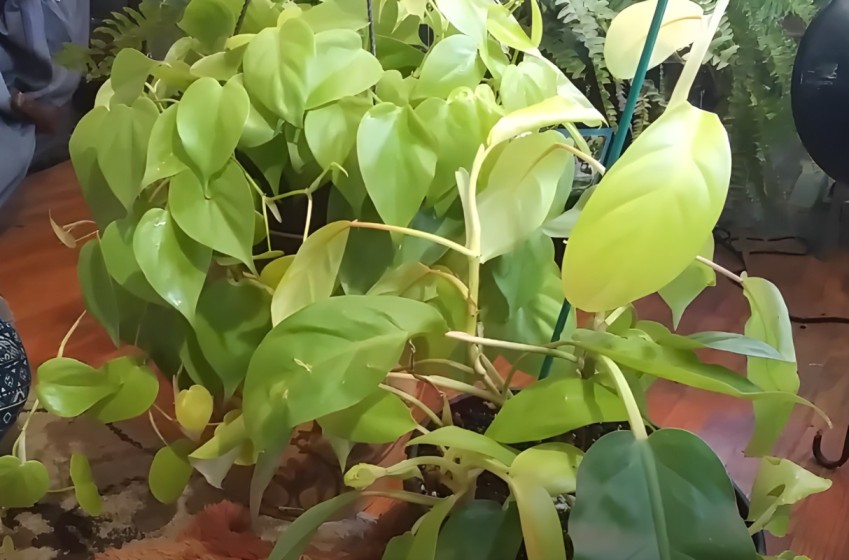
Pruning
Giving your Lemon Lime Philodendron a modest clip to keep it looking neat and healthy is equivalent to pruning it. It’s a good idea to clip any long, lanky stems or leaves that are beginning to turn yellow or brown.
The undesirable sections should be cut off at the point where they meet the main stem using a pair of clean, sharp scissors or pruning shears.
This will promote new development and aid in keeping your plant’s rich appearance. Just keep in mind that removing too many leaves at once will stress the plant. Your Lemon Lime Philodendron will look its best with occasional trimming as needed.
Growth Rate and Size
Depending on its surroundings and care, a Lemon Lime Philodendron can grow at different rates and reach different sizes. These plants often have a somewhat modest growth rate, which means their size will expand gradually rather than suddenly.
Your Lemon Lime Philodendron should grow a few inches taller every year under ideal circumstances. They typically grow to a moderate size for interior environments, with vines that may reach lengths of up to 3 to 6 feet.
Remember that you may somewhat control the size by trimming and controlling how much light and nutrients they receive.
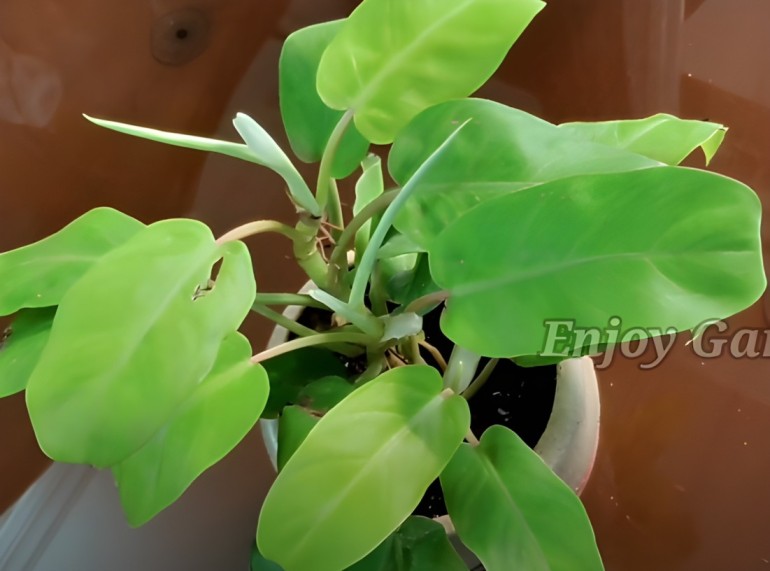
Propagating Philodendron Lemon Lime
Stem Cuttings
- Cut a healthy stem that has a few leaves and at least one node (a little bump on the stem where roots will form).
- Allow the Cut End to Air Dry: To assist avoid rot, let the cut end air dry for a few hours.
- Plant in Soil: Bury the node of the cutting and leave the leaves above the soil when planting it in a potting mix that drains properly.
- Maintain Humidity: To keep the cutting at a high humidity level, place a plastic bag over it or use a propagation tray.
- Root Development: After a few weeks, the new plant should have developed roots, at which point you can move it into a larger container.
Water Propagation
- Take a Cutting: Cut a stem with a node and set it in a jar with water, just as stem cuttings.
- Regular Water Changes: To keep the water fresh and stop rot, change it every few days.
- Root Development: In a few weeks, roots will begin to develop.
- Transplant: You may put the cutting into soil after the roots are a few inches long.
Division
- Separate Roots: For mature Philodendron Lemon-Lime plants, carefully cutting the root ball into smaller pieces will allow you to split the plant.
- Get a Stem and Roots for Each Section: Each section has to have a healthy root system and a piece of the stem.
- Plant the divisions again in separate pots with the right soil.
Aerial Layering
- Choose a Stem: Pick a long, healthy stem, and cut a tiny hole below a node.
- Wrap with wet Moss: Cover the incision with plastic wrap and wrap it with wet sphagnum moss.
- Root Development: As the moss matures, roots will be included.
- Cut and Pot: After the roots have fully formed, cut the stem just beneath the moss, and then plant it in a fresh container.
Offsets
Identify Offsets: The Lemon Lime Philodendron can develop offsets or “pups” at the base of the parent plant.
In order to put these offsets in their own pots, gently detach the parent plant from the offsets.
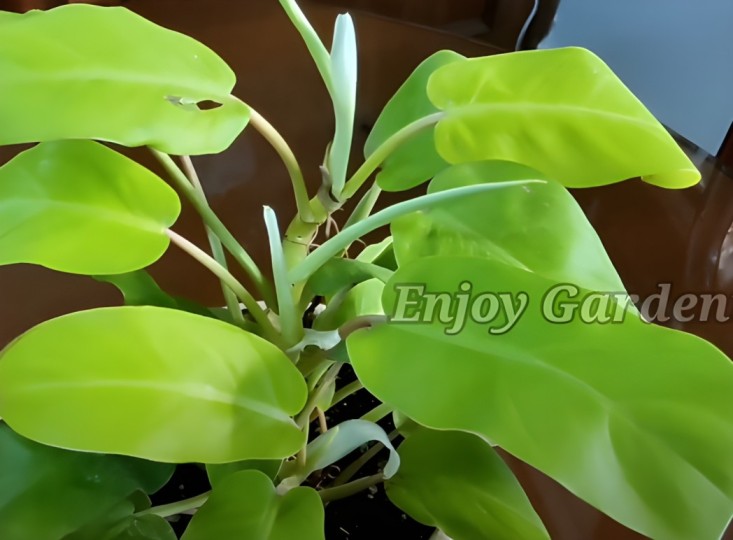
Repotting
Giving your Lemon Lime Philodendron a new habitat with more space to grow is equivalent to repotting it. It’s time when you see that the plant’s roots are crowded or that it has outgrown its container. This is how:
- Select a pot with drainage holes that is somewhat bigger.
- Remove the plant’s old pot with care.
- Fill the new pot with new potting soil.
- Set up the new home for your philodendron.
- Give it plenty of water.
Flowering and Foliage
The Lemon Lime Philodendron which is renowned for its exquisite foliage, has vivid, dark-green leaves that can quickly make any indoor room feel more cheerful. The plant’s major draw is its leaves, which add an appealing touch of colour and lushness.
It’s important to remember, too, that this particular Philodendron is not bred particularly for its blooms. Although it does produce pretty red blossoms, they pale in comparison to the eye-catching foliage.
Since the Lemon Lime Philodendron thrives in direct sunshine and requires regular care to preserve its lush green look, the majority of enthusiasts grow it for its alluring leaves.
Overwintering
To protect the health of your Lemon Lime Philodendron, overwintering is the act of taking care of it throughout the colder months. This tropical plant may be susceptible to cold stress when the temperature drops. Bring your Lemon Lime inside when the temperature falls below 50°F (10°C) to safeguard it.
As it would in its native environment in warm, well-lit Central to South America, make sure it continues to get strong indirect sunshine. By adjusting your watering schedule, you may prevent overwatering, which can cause root rot, and allow the top half of the soil to dry out between waterings.
As interior heating systems can dry up the air, keep the humidity level at 50% or above. You can ensure that your Lemon Lime thrives throughout the winter and is prepared to blossom when spring arrives by following these instructions and keeping an eye out for symptoms of stress on it.
Philodendron Lemon Lime vs Neon pothos
Philodendron Popular indoor plants are Neon Pothos and Lemon Lime. Both Neon Pothos and Lemon Lime Philodendron have bright green foliage with a tinge of yellow, whereas Lemon Lime Philodendron has leaves that are brilliant green with yellow variegation.
Both flourish in similar environments and prefer indirect sun, frequent watering, and soil with good drainage. Personal aesthetic tastes will determine which one you choose; the Lemon Lime Philodendron provides a distinctive lemony twist to your indoor flora, while the Neon Pothos adds a more traditional touch with its spectacular neon-colored leaf.
Common Pests
Pests including thrips, mealybugs, and spider mites can cause problems for your lemon lime plant. These little intruders damage your plant’s leaves or sap by sucking it out.
Regularly check for these pests’ presence to maintain the health of your lively houseplant, and act quickly if you find any by using natural treatments or insecticidal soap.
Plant Diseases
The Lemon Lime Philodendron can have a number of problems, including insect infestations like mealybugs or spider mites, root rot brought on by overwatering, and leaf spots produced by too much moisture.
Maintain correct watering procedures, make sure there is excellent drainage, routinely check for pests, and deal with them right away to keep your plant healthy.
How to Get to Bloom
Make sure your Lemon Lime Philodendron receives enough indirect sunshine and is consistently kept at a temperature of 65 to 80 degrees Fahrenheit (18 to 27 degrees Celsius) to promote blooming.
Water when the top half of the soil is dry and keep humidity levels at 50% or greater. During the growth season, prune as necessary and sometimes fertilize with a balanced fertilizer.
Problems and Solutions
Problem: Yellowing Leaves
Solution: Check the soil’s hydration and remove yellowed leaves to promote new growth. If required, adjust watering.
Problem: Leggy Growth
Solution: Increase indirect sunlight exposure and often rotate the plant to encourage compact development.
Problem: Pest Infestation (e.g., mealybugs or spider mites)
Solution: Isolate the damaged plant and apply neem oil or insecticidal soap to manually eliminate bugs.
Problem: Slow Growth
Solution: Make sure to water your plants properly, fertilize during the growing season, and repot if necessary.
Problem: Brown Leaf Tips
Solution: Increase humidity levels, avoid direct sunlight, and water consistently.
Toxicity
Adding a fascinating houseplant like the Philodendron-Lemon Lime to your home may be a joy. It’s crucial to remember that it has a low level of toxicity if consumed.
Make sure it’s out of reach of curious animals or young children to keep everyone safe, and inform family members about its possible dangers.
Fun Facts About Philodendron Lemon Lime
Popular indoor plants like the Lemon Lime Philodendron have intriguing characteristics. It is an indoor plant that prefers bright, indirect sunshine and is native to Central and South America.
Its dark-green foliage and vivid scarlet blossoms make a stunning contrast. Through stem cuttings or air layering, propagation is simple. However, keep an eye out for any pests like mealybugs or spider mites!
Philodendron lemon lime Appearance
A beautiful indoor plant, the Lemon Lime Philodendron has vivid, dark-green foliage with a lemony-lime tint in the centre.
The compelling contrast that results from this makes it a popular option for interior design. Its luxuriant, glossy foliage and sporadic blooms of vivid red flowers further its alluring charm.
Suggested Uses
With its vivid green foliage, the Lemon Lime Philodendron is a great option for bringing brightness indoors. It’s perfect for both home and business décor because to its eye-catching look and air-purifying capabilities.
Bring a little of nature into your space, you may put it on shelves, in hanging baskets, or as a tabletop centerpiece. Its ease of upkeep makes it ideal for both seasoned and inexperienced plant enthusiasts.
Essential Care Tips for Thriving Lemon Lime Philodendrons
Proper lemon and lime philodendron care is essential to ensure the health and vibrancy of these beautiful plants. When it comes to Lemon Lime Philodendron care, it’s crucial to pay attention to their light and watering needs.
These plants thrive in bright, indirect sunlight, so providing them with the right amount of light is essential. Avoid exposing them to direct sunlight, as it can scorch their leaves.
Distinguishing Between Neon Pothos and Lemon Lime Philodendrons
In terms of watering, knowing when to water your lemon lime philodendron is key. These plants prefer to dry out slightly between waterings, so be sure to let the top inch of the soil dry before giving them a thorough watering. The choice of soil mix for philodendron lemon-lime is also vital.
Opt for well-draining soil to prevent root rot. Repotting your plant when it outgrows its pot is recommended to ensure its continued health and growth.
Additionally, understanding the difference between neon pothos and lemon lime philodendron is crucial for plant enthusiasts. While both have vibrant foliage, the neon pothos has heart-shaped leaves and is not a true philodendron.
The lemon lime philodendron, on the other hand, boasts distinctive elongated leaves with a lemon and lime coloration, making it a unique addition to your indoor garden. With the right care and attention, these plants can thrive and add beauty to your living space.
Conclusion
In conclusion, Philodendron-Lemon Lime maintenance is simple and enjoyable. Use well-draining soil, provide it with indirect sunshine, and water it when the top inch of soil feels dry. Use a water dish or spritz it; it prefers dampness. During the growth season, fertilize, repot as necessary, and trim for neatness.
Quick action maintains it healthy even if it may encounter pests and illnesses. Whether you’re an experienced gardener or a novice, this plant is ideal for any interior area because of its beauty and low maintenance requirements.
FAQs
What is the ideal light condition for Philodendron Lemon Lime?
Lemon Lime Philodendron should be shielded from direct sunlight since it prefers bright, indirect light.
How should you determine when to water your Philodendron Lemon Lime?
To avoid overwatering, water your plant when the top inch of soil is dry.
What type of soil should be used for potting Philodendron Lemon Lime?
It is advised to use potting soil with good drainage and adequate ventilation for the roots.
How can you provide the right humidity for your Philodendron Lemon Lime?
By intermittently spraying the leaves or keeping a tray of water nearby, you can maintain humidity.
When should you fertilize your Philodendron Lemon Lime?
Every four to six weeks during the growing season (spring and summer), apply a balanced, water-soluble fertilizer.
What is the ideal temperature range for Philodendron Lemon Lime?
Avoid draughts and keep the plant in a room with a temperature range of 65°F to 80°F (18°C to 27°C).
How can you propagate Philodendron Lemon Lime?
It may be multiplied through stem cuttings, aerial layering, division, water propagation, or offsets.
What pests should you watch out for when caring for Philodendron Lemon Lime?
Spider mites, mealybugs, and thrips are typical pests that need to be inspected frequently and treated if discovered.


